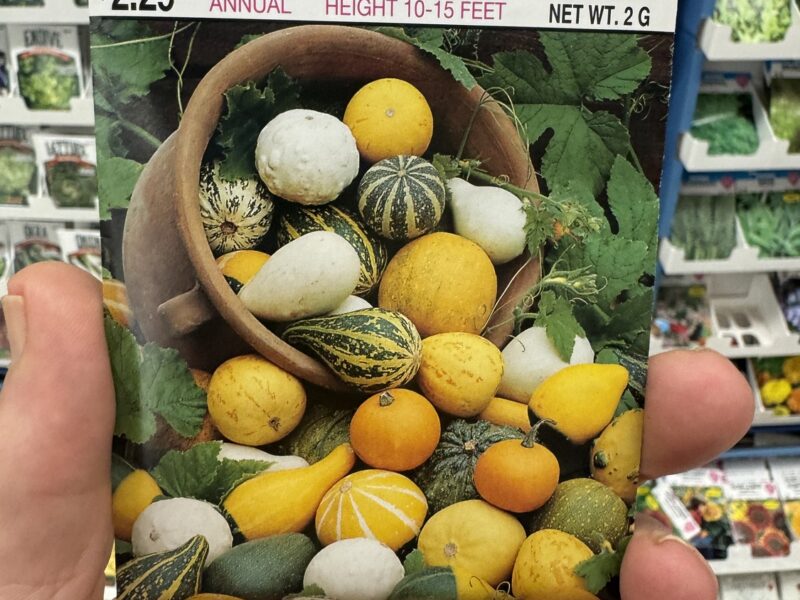

It’s not too late to plant a few seeds that can be a great project for kids and adults of all ages. And this project has the potential to keep the kids curious for months.
Time is short, though, and these seeds need to get in the ground like yesterday. Some like to haphazardly plant these seeds throughout the garden and forget about them just to see what happens. Others plant them with intent and purpose. But no matter what your objective is, the gourds that result and show up in the gardens when other plants begin to fade away come fall can be a wonderful surprise and treat for all.
The myriad shapes, colors and configurations of gourds make them festive fall ornaments, and they’re a colorful element to bring indoors or leave as a welcome on the front steps. Gardeners often see them at farmers markets and garden centers and make mental notes to grow their own “next year.” Well, it’s next year, and now’s the time to sow the seeds.
Gourds can go for more than $10 apiece in the market come November, yet they cost only pennies to grow at home. Even better, they are easy to grow, great fun for kids and after all, they’re just squash — kind of. Gourds have also been used historically for musical instruments, and once dried they can also be used as birdhouses.
These plants grow slowly all summer long, much as their cousins, edible winter squash and pumpkins. Speaking of which, you may want to keep your gourd plants separated from other squashes because they can cross-pollinate, yielding interesting results.
Sow these seeds right now, or from transplants if you can find them. The plants won’t produce ready-to-pick, multi-hued gourds until September or October. They should be picked after their stems turn dry and woody and the skin becomes hard, like plastic, but before our first frost. When picking, try to leave as long a stem on each fruit as possible. Snapping off the stem will leave a “wound” or vulnerable spot on the gourd that may encourage rotting. Unlike the related zucchinis though, gourds grow at a glacial pace, but your patience is rewarded in a harvest of different sizes, shapes, colors and markings.
Some are as small as a golf ball, others the size of a large grapefruit. Some are knobby, others smooth, and the color variations include piebald gold and white, reds, green with stripes, and even polka-dotted and textured. In all there are over 30 varieties in three groups or types to choose from. And yes, for those of you who choose to become obsessed and carried away with these things, there is the American Gourd Society at americangourdsociety.org, where you can explore gourds to your heart’s content.
Growing decorative gourds for fall is just half the fun, however. Once harvested, they need to be cured — the process of drying and hardening them further so that they will keep indefinitely. And if you really want to get carried away, there’s a long history of man, modern and ancient, using gourds as musical instruments.
To cure gourds, put them outside on sunny days. They should be placed on a dry board or cardboard, so that they are not touching moist soil. Don’t leave them out overnight or they will be moistened again by dew and bitten by frost. Ideally, they should be turned each time they are put out in the sun. They should be sun-dried like this for about a week, weather permitting. Large ones will take longer. Generally, the faster they can be sun-cured, the better they will keep. Once cured, gourds can be cleaned off with a damp sponge and oiled lightly with spray oil or shellacked.
Birdhouse gourds need sun-curing treatment for about 10 days to two weeks. They’ll be fully cured when the rattling sound of seeds can be heard when the gourds are shaken. If you are clever with a jigsaw or small pruning saw, cut a 2-inch hole in the bowl of the gourd to make an entrance for small birds. In the spring, hang the birdhouse gourd by its long neck from a tree, and a chickadee or wren will make a home in it rewarding you for your efforts by eating insect pests around the garden as a new crop of gourds reaches maturity.
There are many varieties of gourds, ranging in size and shape from the small, green-and-tan striped oval kind to the large birdhouse gourds with their swan-like necks and fat bowls and others looking like weird creations of science. They all share a similar growth habit — sprawling vines with large leaves and the tendency to take over a garden plot if permitted. Most garden center seed racks will have packets on display.
Like all squash, gourds thrive in good garden soil enriched with organic matter, plenty of mulch for maximum soil retention and monthly feedings of an organic fertilizer that encourages steady growth throughout their lengthy season. Full sun and regular watering keep the plants healthy and able to withstand pests that are likely to visit in the summer.
Because of their natural exuberance, growing locations should be chosen with care: A corner of the garden or a distant spot is ideal, and if you want to have some fun, plant a few in your beds and borders for fall surprises. To save space in more formal plantings you can grow the vines vertically, up a trellis or fence. If you decide to wait until next year to do your planting, remember that these are heat-loving plants and putting them out too early — before June 1 — may result in unwanted failures or very slow growth.
Gourd seeds germinate very rapidly in warm soil — a helpful thing to know when children are doing the growing. Within six weeks of sowing it’s not uncommon for the plants to be a foot tall with a 3-foot spread. Unfortunately, from this point onward, like all squash, gourds are susceptible to the squash vine borers and squash bugs. Borers drill holes in stems and eat plants from the inside. The best defense against the squash vine borer caterpillars is diatomaceous earth or dry wood ashes placed around the base of the plants. You can also drape the plants with garden fabric like Reemay from mid-June to mid-August while the borer moths are actively laying eggs, but remove the fabric when the vines are flowering as bees are needed for pollination.
Trellising squash vines (remember, gourds are really ornamental squashes) seems to reduce pest populations; some spraying from early July through early September will help to curb the destructive squash bug, which may take a toll on the vines. If infestations get bad, pyrethrin sprays are effective, but they may also harm bees, which are important to gourd production because they pollinate the plants and enable the formation of fruits.
Gourd squash were not developed or bred for flavor but rather for their appearance. However, the young squash are edible, although one should not count on much taste. Once the hard shell develops with maturity, the interior flesh loses its charm. The blossoms, like all squash, are edible.
Plant and forget. Give the kids a great summer project that will surprise them in the fall. Plant and eat, plant and plan but whatever you do, keep growing.
 More Posts from Andrew Messinger
More Posts from Andrew Messinger